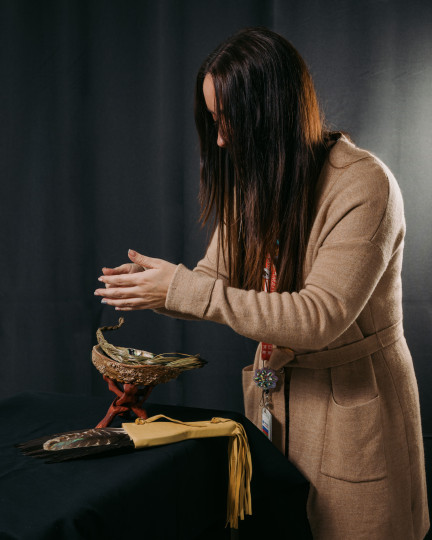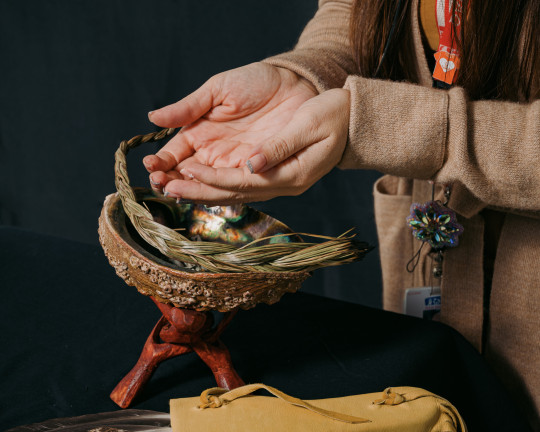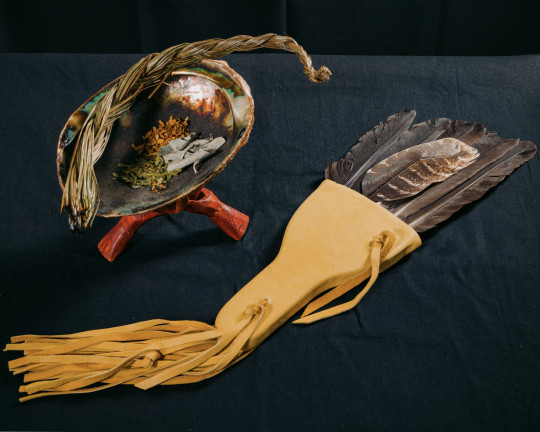(By Kristen Lipscombe)
For IWK Health’s Indigenous Health Consultant Courtney Pennell and her fellow community members, the ability to carry out traditional ceremonies such as Smudging in a hospital environment is “a human right.”
“It is a human right and a Truth and Reconciliation Health Call to Action to access traditional medicines, so it’s really not a question of permission, but it’s really about finding ways to do it safely,” explains Pennell, who is also a registered nurse and is of Mi’kmaq descent. “It’s a way of life.”
That’s why Pennell continues to strongly advocate to ensure the practice of Smudging is incorporated within the walls of the IWK Health Centre, where ceremonies conducted for various religious ceremonies aren’t questioned.
“When we have the educational tools, we can do better,” she says. “We know more, we can advocate, we can be better allies.”
That’s where the IWK’s Smudging Policy, which Pennell has worked hard to implement, comes into play.
As of June 2023, IWK Health employees “must facilitate all smudging requests,” but ceremonies still can’t take place in positive pressure rooms or where oxygen is administered. Pennell hopes to receive further approval to amend those policy pieces soon.
In the meantime, she’s ecstatic to have herself carried out the very first Smudging ceremony when the new policy was implemented for her twin sister Brittany Pennell and her newborn son Beau Joseph Bear this past June. The act of doing so represents big steps forward for the rights of Indigenous communities being recognized within health care facilities, although Pennell emphasizes there’s still a long road ahead before true equity is reached.
As for Smudging itself, it’s a practice that Pennell and many Indigenous community members carry out in their daily lives.
“Smudging has been done for thousands of years,” she says, noting that not all Indigenous communities partake in the ritual.
“Smudging in and of itself is the act of wafting the smoke over one’s being,” she explains, “so it’s sacred smoke that’s created from the burning of medicinal/scared plants, in many cultures and religions across the world, not just specific to Indigenous communities, but in Turtle Island, or North America, it’s a common practice for Indigenous folks.”
While Smudging is often incorporated daily, Pennell said it’s also vital during significant life-altering situations, in times of celebrations and crisis, whether a baby is being born into the Earth side, when patients are facing serious illness, or journeying into the Spirit realm.

“These are the most critical situations that we would want to access traditional healing remedies and ways of life,” Pennell says, which is why there is still much work to do to ensure the Smudging policy continues to evolve as the hospital environment learns how best how to incorporate these traditions.
So, what is Smudging, exactly?
“No one smudging ceremony is the same; they differ vastly from people to people, from culture to culture, from tribe to tribe,” Pennell says. “For me, it can be different when I do it for personal purposes versus facilitating for an audience, but it’s traditionally a ceremony to purify or cleanse your soul, being, mind, spirit and environment of negativity.
“You can also bless or cleanse a space, place, an object, a person,” she explains, adding the container, is typically an Abalone Shell utilized to perform the Smudge and represents the element of water, with the four sacred plants of tobacco, cedar, sage, and sweet grass, which are considered gifts from Mother Earth, carefully placed into the ceremonial shell for their different healing properties.
“During a Smudge, those medicinal plants, their stems and leaves, are placed in a container, shell or Smudge dish and ignited, preferably with a wooden match,” Pennell says. “That’s more traditional and has a more sacred context behind it than using a typical lighter.”
“The flames are gently snuffed out, usually with a fan, your hand or a feather… and once the flame is snuffed out, the medicines produce the smoke, which is what carries the prayers to the Creator and our ancestors and Spirit Guides, which heals the mind, body and spirit,” Pennell says.
“When we bring the smoke over our being, it’s typically done in a head-to-toe fashion, and some folks will gently inhale the smoke so that it cleanses their inner components. And the ashes, once the ceremony is complete, are returned to the Earth on bare soil, or perhaps under a tree.”
The act of returning the ashes back to the element of Earth, means returning the medicines back to where they were retrieved from.
Meanwhile, the element of fire is represented when the sacred plants are lit within the shell or bowl, while the element of air is represented in the smoke produced from the burning of the medicines. The smoke produced through Smudging is quite minimal and completely safe, Pennell says, which is why Smudging within a hospital environment shouldn’t create major concerns – although questions about the impact of smoke often arise.
How are the four sacred plants used in Smudging?
The tobacco used in Smudging, Pennell emphasizes, is very different from that used in cigarettes, for example. “They are vastly different products,” she says. “The Indigenous or traditional use of tobacco is organic in nature, so it doesn’t have additives, toxins or any carcinogenic properties.”
Tobacco is, in fact, “was the first medicine given to Indigenous people,” Pennell says. “That’s our oldest gift and is known to open the doorway to the Spirit realm so that we can then have an appropriate channel of communication to ask for assistance from our ancestors, spiritual beings and the Creator.”
Tobacco also symbolizes “harmony and peace” in the Smudging ceremony and is often gifted to Elders and others as a thank you or peace offering.
The cedar branches incorporated into the ceremony represent “medicine that helps protect us from the unknown or unseen,” Pennell explains, such as the “emotions and feelings of others.”
“So, if you put yourself in an environment, in a space full of people and you start to feel uneasy or you see people throwing daggers your way – you’re the new kid at school kind of feeling – it’s used as a shield, to protect you. It’s a cleansing medicine against lingering spirits, or emotions and feelings of negativity that can disrupt daily living.”
The sage used in Smudging has quite a potent smell, Pennell says, with the male version referred to as Buffalo Sage, stemmed with leaves, while female sage has flowers and contains seeds to produce the following year’s crops.
“Sage protects us from ourselves by offering relief from internal struggles,” Pennell explains. “It brings calmness, which allows us to adjust and make better decisions. It’s often the one medicine that’s used to start your day or a meeting in a good way.”
Pennell’s personal favourite sacred plant, sweetgrass, smells much like vanilla and contains purplish roots.
“It’s known as the hair of Mother Earth and it represent sharing, caring and love, as well as mother, father and child,” Pennell explains. “Its sweet aroma calms us with thoughts of family and loved ones and like your hair, unbraided, it moves in the breeze.”
The sweetgrass can also be braided, which is also important to Indigenous communities when it comes to their hair. “The teaching with about hair is that it’s an extension of our nervous system and so we braid our hair,” says Pennell, whose dark hair hangs down her low back. “We are only to think good thoughts and to carry ourselves in a good way. Hair is super sacred; it’s more than just vanity.”
The importance of hair is very much like the significance of sweetgrass, Pennell explains. “When we intertwine it there are beautiful teachings in and off itself.” In total, there are 21 strands of sweetgrass all representing different teachings and values.
All of these sacred plants also have medicinal uses that are used by Indigenous folks daily, whether that’s using cedar in a steam bath to incorporate the benefits of its anti-inflammatory, antioxidant, and antibiotic properties; creating a balm out of sage to treat swelling, ulcers, and wounds; or steeping teas with some of these herbs to treat coughs and sore throats.
“These medicinal properties go back generations across many Indigenous cultures,” Pennell says.

What’s next for Smudging at the IWK?
“There are so many beautiful teachings with Smudging,” Pennell says, adding bringing these traditions back, including within hospitals, is pivotal to advancing Indigenous health, revitalizing Indigenous traditions, and incorporating equity within the health care system.
In fact, she points out, creating a culturally safe environment for Indigenous peoples to exercise their spirituality aligns with the TRC Health calls to action, United Nations Declaration on the Rights of Indigenous Peoples and the Canadian Charter of Rights and Freedoms.
Supporting Smudging is a key step towards redressing the legacy of Residential Schools and addressing the Truth and Reconciliation Calls to Action (#22), which calls for “those who can effect change within the Canadian health care system to recognize the value of Aboriginal healing practices and use them in the treatment of Aboriginal patients in collaboration with Aboriginal healers and elders where requested by Aboriginal patients.”
Nevertheless, challenges still exist. However, legislation such as the provincial Smoke-free Places Act protects the rights of Indigenous people, respecting traditional spiritual or cultural practices or ceremonies, and the ability to prohibit Smudging within the hospital setting.
Smudging needs to be normalized within the health care system, Pennell says.
“This is really about the reclamation and revitalization of traditions and culture, and the value and the sacredness of our people.”
Mik’maq culture is matrilineal, Pennell adds, “we really hold the beauty, spirituality and power of our women, and two-spirited folks with high regard, and the same with children as they are the future.”
That’s why it’s so important for Indigenous communities have access to traditional healing methods within health care facilities such as the IWK, Pernell says, especially since it’s a major secondary and tertiary health care facility, servicing predominantly women, families, children and youth.
“It’s critical, it’s empowering, and allows the community to practise what they have been denied of for far too long,” Pennell says.
“It allows for culturally safe and equitable access to health care.”
